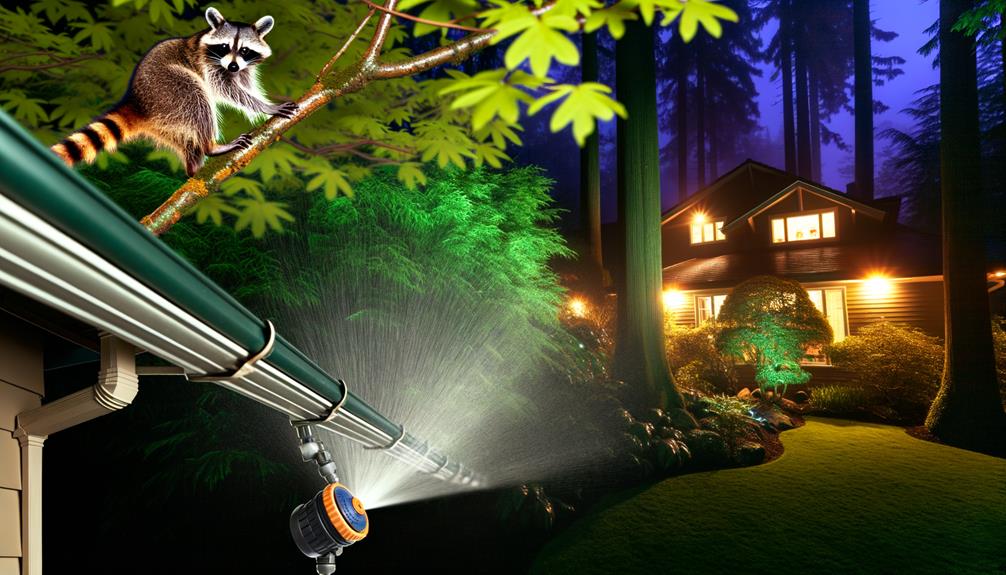7 Tips to Keep Raccoons off My Roof
Preventing raccoons from accessing your roof involves regular inspections and promptly sealing any potential entry points. Install metal flashing, chimney caps, vent covers, and gutter guards to create physical barriers.
Natural repellents like peppermint oil, cayenne pepper spray, and ammonia-soaked rags can deter raccoons when applied safely and regularly. Motion-activated lights, ultrasonic repellents, and water sprayers also effectively ward off these nocturnal climbers.
For persistent issues, seek professional wildlife control for humane trapping and exclusion. By implementing these strategies, you can protect your property and maintain peace of mind, exploring additional detailed steps can further enhance your efforts.

Key Takeaways
- Conduct regular inspections to identify and promptly seal potential entry points on your roof.
- Install metal flashing, chimney caps, vent covers, and gutter guards to block raccoon access.
- Use natural repellents like peppermint oil, cayenne pepper spray, and ammonia-soaked rags, reapplying them regularly.
- Set up motion-activated devices such as lights, ultrasonic repellents, water sprayers, and sound emitters.
- Seek professional help for humane trapping, exclusion techniques, and tailored recommendations for securing your property.
Understand Raccoon Behavior
Understanding raccoon behavior is crucial for effectively keeping these persistent animals off your roof and preventing potential damage. Raccoons are nocturnal creatures, highly intelligent, and adept climbers. They often seek out attics for shelter, especially during breeding seasons.
Recognizing their patterns, such as foraging for food at night and resting during the day, can help you anticipate their movements. Raccoons are also attracted to accessible food sources; securing garbage bins and removing pet food can deter them.
Additionally, being aware of their ability to squeeze through small openings and their tendency to return to previously successful locations can inform preventative measures. By understanding these behaviors, you can implement appropriate strategies to safeguard your home and ensure the safety of all inhabitants.
Secure Entry Points
Securing your roof against raccoon intrusions is paramount for maintaining the integrity of your home.
Conduct regular inspections to identify potential entry points, such as gaps, vents, and loose shingles.
Promptly seal any discovered openings with durable materials to prevent these persistent pests from gaining access.
Inspect Roof Regularly
Regular roof assessments are necessary for identifying and securing potential entry points that raccoons can exploit. By conducting thorough evaluations, homeowners can detect vulnerabilities such as loose shingles, damaged vents, and deteriorating fascia boards.
Utilizing a professional-grade flashlight, inspect all roof areas, including the eaves and soffits, for signs of wear or gaps. Pay attention to any structural weaknesses or holes that may serve as entryways for raccoons. Additionally, make sure that all roof-based utility access points, such as chimneys and skylights, are adequately secured.
Taking these proactive measures not only prevents raccoon intrusions but also maintains the overall integrity and safety of your home. Regular assessments and timely repairs are essential in safeguarding your property from potential wildlife invasions.
Seal All Gaps
After identifying potential entry points during your roof inspection, the next step is to seal all gaps to prevent raccoon access. Prioritize using sturdy materials like metal flashing or hardware cloth, which raccoons cannot chew through. Pay special attention to areas around vents, chimneys, and eaves.
Guarantee that all vents are covered with heavy-gauge hardware cloth and that chimneys have secure caps. When sealing gaps, use a high-quality exterior sealant to fill smaller cracks and crevices. Remember to check and reinforce your work periodically, as weather and wear can create new vulnerabilities.
Install Roof Barriers
Installing roof barriers is a highly effective method to prevent raccoons from accessing your roof and causing potential damage. By implementing strategic barriers, you can safeguard your property and guarantee the safety of your household.
Here are four practical steps to contemplate:
- Install metal flashing: Place metal flashing around the edges of your roof to deter raccoons from climbing.
- Use chimney caps: Secure a cap on your chimney to block entry points, ensuring it is securely attached.
- Apply vent covers: Install heavy-duty vent covers to prevent raccoons from accessing attic spaces.
- Set up gutter guards: Use sturdy gutter guards to eliminate climbing routes and protect your gutters from damage.
These measures provide an effective, humane way to keep raccoons at bay.
Use Natural Repellents
To keep raccoons off your roof, employing natural repellents can be an effective and environmentally-friendly strategy. Peppermint oil, for example, can deter raccoons due to its strong scent. Soak cotton balls in peppermint oil and place them around potential entry points.
Additionally, combining cayenne pepper and water in a spray bottle can create a spicy mixture that raccoons find unpleasant. Spray this solution along the roof edges and any accessible areas. Ammonia-soaked rags also serve as a strong deterrent when placed in strategic locations.
While utilizing these methods, make sure that all substances are safely handled and kept away from children and pets. Regularly reapply these repellents, especially after rain, to maintain their efficacy.
Employ Motion-Activated Devices
Incorporating motion-activated devices can effectively deter raccoons from accessing your roof by startling them with sudden lights or sounds. These devices offer a humane and practical solution to prevent raccoon intrusions while ensuring the safety of your home and family.
Consider the following types of motion-activated devices:
- Motion-Activated Lights: Install these around the perimeter of your roof. The sudden illumination can frighten raccoons, causing them to flee.
- Ultrasonic Repellents: Emit high-frequency sounds inaudible to humans but unpleasant for raccoons, discouraging them from approaching.
- Water Sprayers: Position these to activate when motion is detected, delivering a harmless but startling burst of water.
- Sound Emitters: Devices that produce sudden, loud noises can effectively scare raccoons away.
Implementing these devices can provide peace of mind and protect your property.
Maintain Your Yard
A well-maintained yard is essential in discouraging raccoons from venturing onto your roof. Regularly trimming trees and shrubs reduces potential climbing pathways. Ensuring compost bins are secure and garbage cans are tightly sealed can deter raccoons from foraging. Removing debris and clutter minimizes hiding spots, making your yard less attractive to these nocturnal creatures. Below is a table that summarizes key yard maintenance practices:
| Task | Frequency | Safety Tip |
|---|---|---|
| Trim Trees/Shrubs | Monthly | Use proper pruning tools |
| Secure Compost | Weekly | Check for loose lids |
| Clear Debris | Bi-weekly | Wear gloves to avoid cuts |
These practices not only enhance yard aesthetics but also play a pivotal role in raccoon prevention.
Remove Food Sources
To effectively deter raccoons from accessing your roof, it is essential to remove food sources that attract them.
Securing trash bins with tight-fitting lids and eliminating bird feeders can greatly reduce the temptation for these animals to explore your property.
Secure Trash Bins
Securing your trash bins with tight-fitting lids and locking mechanisms is essential to prevent raccoons from accessing food sources on your property. This not only deters raccoons but also maintains a clean and safe environment for your household and neighbors.
Here are some effective strategies:
- Use Heavy-Duty Bins: Invest in sturdy, animal-resistant trash bins designed specifically to withstand raccoon tampering.
- Locking Mechanisms: Employ bins with built-in locks or add aftermarket locking straps to ensure lids remain firmly closed.
- Routine Maintenance: Regularly inspect and replace damaged bins or lids to maintain a secure barrier against wildlife.
- Strategic Placement: Position bins away from easy climbing routes such as fences or trees to further reduce access.
Implementing these measures will greatly reduce raccoon-related issues.
Eliminate Bird Feeders
Removing bird feeders from your property is an important step in eliminating food sources that attract raccoons. These nocturnal creatures are opportunistic feeders and birdseed serves as an easy meal, increasing their likelihood of venturing onto your roof. For those committed to helping wildlife, consider alternative feeding strategies that do not draw raccoons.
| Impact on Raccoons | Emotional Response | Safety Measures |
|---|---|---|
| Reduced attraction | Relief | Secure storage |
| Decreased roof visits | Peace of mind | Install barriers |
| Encourages natural foraging | Contentment | Regular checks |
| Lower risk of damage | Confidence | Professional help |
Apply Chemical Deterrents
Chemical deterrents can be an effective method for keeping raccoons off your roof while ensuring safety for both the animals and your property. These deterrents are designed to repel raccoons without causing harm.
Here are some recommended options:
- Commercial Repellents: Available at most hardware stores, these sprays contain ingredients that raccoons find unpleasant, such as capsaicin or predator urine.
- Ammonia Soaked Rags: Placing ammonia-soaked rags around your roof perimeter can deter raccoons due to the strong odor.
- Citrus-Based Solutions: Raccoons dislike the smell of citrus; applying citrus oil or peels can be effective.
- Motion-Activated Sprinklers: Though not chemical, these devices can be combined with deterrents to startle and repel raccoons effectively.
Always follow manufacturer instructions for safe application.
Seek Professional Help
While chemical deterrents can be effective, sometimes it is necessary to enlist the expertise of wildlife control professionals to guarantee a thorough and safe solution to keeping raccoons off your roof. These specialists have extensive knowledge in humane trapping and exclusion techniques, verifying that the animals are relocated without harm.
Additionally, they can identify potential entry points and provide tailored recommendations for securing your property. Engaging professionals not only mitigates the risk of injury to you and the raccoons but also confirms compliance with local wildlife regulations.
For homeowners committed to maintaining a safe and healthy environment, relying on experienced wildlife control services is a prudent and responsible approach, ultimately fostering a harmonious coexistence with local wildlife.
Conclusion
To wrap up, deterring raccoons from accessing rooftops requires a multi-pronged strategy, combining knowledge of their behavior with strategic interventions.
By securing entry points, installing barriers, utilizing natural and chemical repellents, employing motion-activated devices, and maintaining a neat yard, one can effectively reduce the risks associated with raccoon invasions.
Like a fortress that cannot be breached, a well-protected roof ensures safety and peace of mind, underscoring the significance of proactive and thorough measures in wildlife management.






